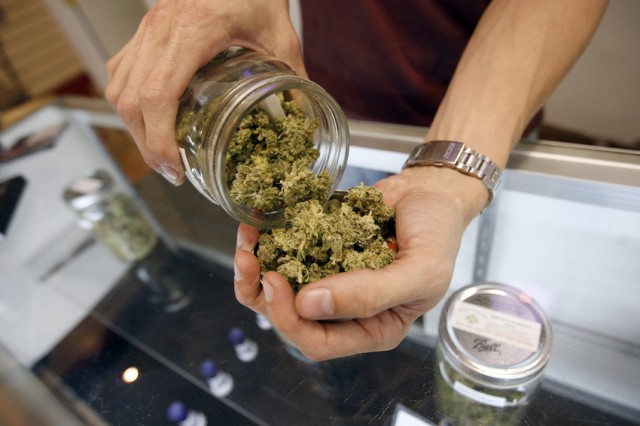"Camille could be in a seizurey state for three days," Kohr recalled. "Her eyes were blinking and rolling back. Her speech was degraded; she couldn't talk very well. She couldn't really walk. And then she would have grand mal seizures when her whole body would shake and convulse."
Today, Camille has gone off all but two medications. She's having fewer seizures. She's thinking faster, talking more, cracking jokes, and, her mother says, able to connect with people.
"For instance, today we went to the vet," Marian Kohr said. "She was the one who spoke to the vet. I stood behind her, and … she answered all the questions. She would never have been able to do that before."
Special strain of marijuana
The extract Camille takes isn't typical marijuana. Her parents grow a strain that is rich in the compound cannabidiol -- or CBD -- and low in tetrahydrocannabinol, or THC. THC is the chemical that makes users feel high. Some studies indicate CBD can reduce seizures, minimize inflammation and prevent brain damage after an injury. Despite California being the first state to legalize medical marijuana, parents like the Kohrs still face an uphill battle when it comes to finding high-quality cannabis this is also high in CBD and low THC.
Then there's the issue of trying to figure out how much to give their daughter. A prescription for medical marijuana isn't like one for antibiotics. Kohr says he was given a "recommendation prescription" from a doctor. But he couldn't get any information about where to buy the cannabis or a dosage.
The Kohrs opted to form a collective with more than a dozen other Bay Area families. They call it the "Green Girls Collective."
"There's all these parents where we're all figuring it out," Kohr says, "with our children, in our kitchens and in our homes and telling each other. It's a really unique state of affairs."
The collective allows parents to buy cannabis from commercial growers, legally under state law. Still, many parents are nervous they'll get in trouble with Child Protective Services or their children's school administration. And not all children respond as Camille has. Some parents stop giving cannabis to their kids because they haven't seen a benefit.
Researchers are at a loss to explain how CBD works or why it works in some patients, but not others. Part of the problem is that the government classifies marijuana as a Schedule 1 drug -- something with a high potential for abuse and no accepted medical use. This means it's harder for a clinical researcher to study the effects of marijuana than cocaine. And this isn't just a U.S. problem -- there are similar restrictions on marijuana research in much of the world.
Dr. Joseph Sullivan says he doesn't want to get on a "political soap box," but he calls these policies "crazy."
Sullivan directs the Pediatric Epilepsy Center at the U.C. San Francisco Bennioff Children's Hospital. Many of the children in the Green Girls Collective are his patients, though he doesn't give advice about dosing or where to get CBD. The current lack of research, he says, is frustrating and confusing.
"We don't really know the actual doses of CBD that are required to get optimal seizure control," he says. "In those patients of mine who have been taking their own naturally prepared tinctures some are responding to extremely low doses and others are requiring very, very high doses and still may not be responding."
CBD-enriched cannabis, the kind that Mark and Marian Kohr grow, still contains some THC. As the dose of CBD gets higher, parents worry about giving their child too much THC. Some data indicate THC can hamper brain development and promote convulsions -- exactly what parents are trying to avoid.
New research starting
But now families have a new hope. UCSF is one of six centers in the U.S. testing a pure form of CBD made by a British drug company. This is the first time the FDA has approved the experimental testing of a cannabis-derived drug designed for children. At the same time, the Drug Enforcement Administration still considers CBD, a Schedule 1 drug. Roberta Cilio, the UCSF neurologist who is leading the investigation, had to get a DEA license and pass an extensive background check.
"I was interviewed twice and then they came to look at the premises, Cillo said. "The cabinet we usually use for narcotics is not enough, so the drug has to be kept in a safe. And really it's a very big complication even for a very experienced investigational pharmacy as we have here at UCSF."
Since the hospital pharmacy didn't have one, a benefactor donated a safe. The pharmacists also had to go through DEA approval and training to handle the drug. To start, Sullivan and Cilio are only allowed to enroll about 25 patients. But the interest from families has been enormous and, they worry, overly optimistic.
"I think the frenzy has been augmented by the fact that this is looked at as a natural substance and therefore it must not have any side effects which I think we really need to be careful about," Sullivan said.
What's needed, the doctors say, are larger, placebo-controlled studies. If the drug proves effective for the initial patients, the drug company hopes to begin clinical trials and push for regulation. As parents and patients lobby for marijuana legislation reform, says Sullivan, political winds seem to be shifting.
